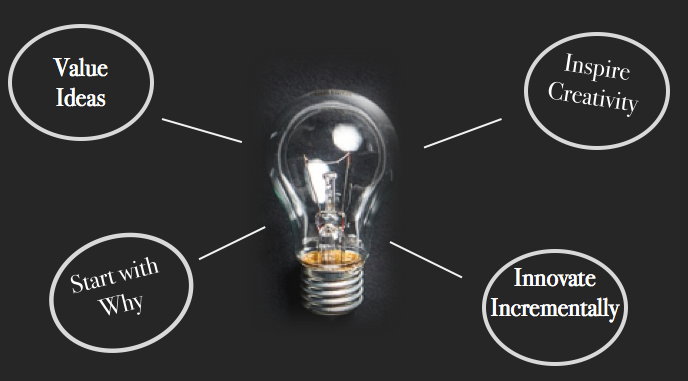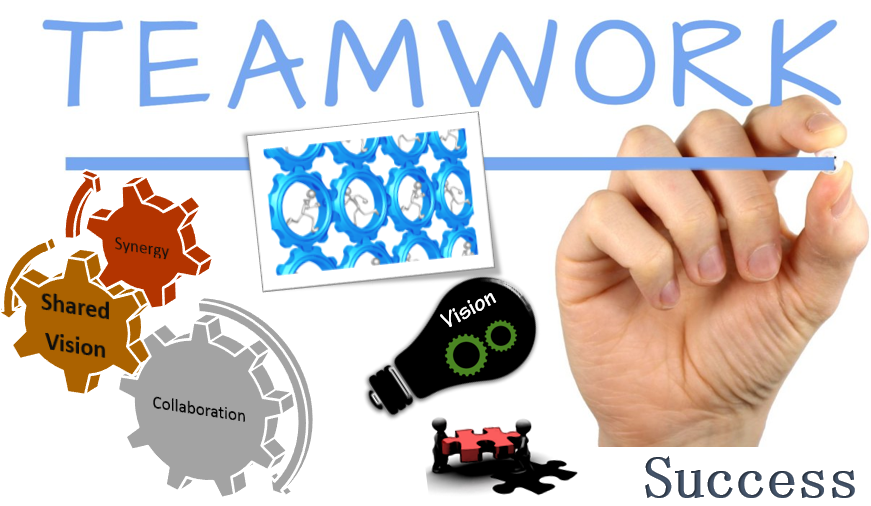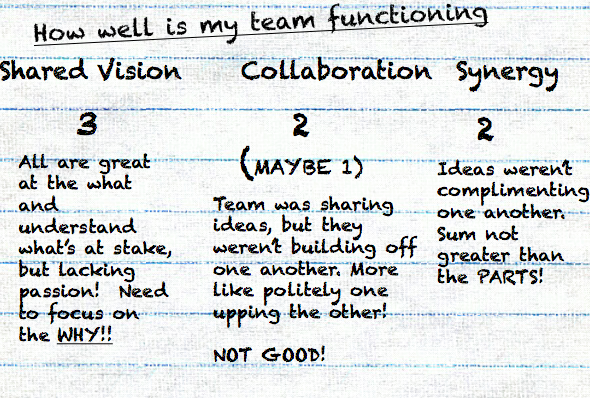#readthisseries: Innovation
Check out this new vblog on what to read this month. We’ve been talking innovative thinking and we recommend a great read to get you thinking as a leader.
Check out this new vblog on what to read this month. We’ve been talking innovative thinking and we recommend a great read to get you thinking as a leader.


Businesses often fail to innovate because of the organization’s culture and not the people. In fact, it’s misleading to believe that the people in the organization are the ones thwarting new ideas. There’s only one person in an organization who can truly squash any innovative thinking, and that one person is the CEO. It’s only the principal, the chief officer, the managing supervisor, or anyone directly in charge of a group of people who can actually suppress innovation. Furthermore, one department within an organization can be cranking out new ideas all the time, working right alongside a department that cannot make any forward progress. As John Maxwell says, “everything rises and falls on leadership” (Maxwell, 2012). The good news for leaders is that there are ways to fix this so that your team is working together, thinking together, and innovating.
Why is Innovation so Important?
Tony Robbins once said that the only two things that matter in business are 1. Marketing, and 2. Innovation. He draws this conclusion for two reasons: 1. Because if you have a wonderful new idea that you can’t market well and sell, it’s worthless. It’s merely an idea. And, 2. Sometimes an innovation is so creative and so inspiring that it doesn’t really need marketing to sell. The product itself is so desired by the market that it moves all on its own. Doing both of these well requires a style of thinking that great leaders possess, but it’s not enough for one person to be the innovator. Most leaders want this type of innovative thinking to permeate the organization and to spur success. At TheSchoolHouse302, we believe in getting to simple with research-based strategies and so we put together four simple strategies that can support any leader’s efforts to build a culture of innovation in the workplace:
4 Strategies to Drive Innovative Thinking:
Strategy #1: Value ideas over everything else. This is about risk taking. “Risk taking is an increasingly critical element of leadership and essential for leader’s effectiveness” (Tull, 2016). The greatest leaders didn’t become successful by playing it safe and the same goes for organizational success, but too often organizations instill a play-it-safe mentality in workers because mistakes are seen as a performance problem. Risk taking, of course, cannot become reckless, but the value of teamwork and employing great people has to be placed on ideas and taking risks with learning and exploring and not the status quo. This means that leaders have to place extreme value on a continual flow of ideas so that thinking is new and not stagnant. Complacency is the death of progress.
Consideration: Why did Blockbuster lose its foothold on the homemovie and videogame market?
Strategy #2: Inspire creativity through the building blocks of innovation. This is about learning to be innovative. In his book, Pure Genius, Don Wettrick (2014) outlines the fact that innovation is cultural and schools, classrooms, and organizations can all spark innovation through teaching the foundation of innovative thinking. It’s important for organizations to explicitly inspire people to take risks (where the leader models risk taking), to collaborate for synergy, to connect so that ideas are curated and then synthesized, to engage in a creative process that isn’t linear, and to always reflect on both the product and the journey in getting to it. Creativity is not a congenital trait but rather something that can be inculcated by culture and expectation.
Consideration: Why did Play-Doh go from a cleaning product to a staple for children in the arts-and-crafts market?
Strategy #3: Always start with WHY. This is about having clear core values. As Simon Sinek explains in his book, Start with Why, great leaders know that inspiration comes from purpose, not from product or process (Sinek, 2011). Bottomline profitability, efficiency, narrow focus, and top-down management practices are just some of the reasons that contribute to an innovation void. But, when organizations have a clear set of communicated core values that drive shared decision-making, it allows for innovation to ensue because people are focused on the importance of the work and the mission at hand. This means that organizational culture has thinking and buy-in at its core rather than just following policies and doing the work.
Consideration: Why does a company like Apple continue to innovate even when their products are flying off the shelves?
Strategy #4: Allow innovation to be incremental. This is about small steps in the right direction. We interviewed @dougtimm34, an elementary principal who values innovation and leadership and who believes in what he calls “incremental innovation.” Innovation doesn’t have to be a massive change. It can be iterative. Doug explained that innovative thinking doesn’t have to be about introducing something brand new but rather allowing yourself to have a process of revision where the end product is new and creative as a result of lots of efforts and input to refine ideas over time. The refinement process includes feedback from others and is used in top creative organizations like Pixar and Disney Animation where everything from the storyline to the characters’ features go under review by teams of people before accepting a new product for development (Catmull, 2014). Tiny tweaks are always at the core of great change.
Consideration: Why does psychologist Amy Cuddy recommend making small nudges toward a goal rather than trying to take a huge leap?

Using these four strategies in your organization will work to create a culture of innovation where new ideas are paramount to the fabric of what you expect as a contribution from everyone on your team. These strategies are complex by the nature of doing business with people, but they are not complicated and any leader can put them into place with thoughtful consideration and focus.
TheSchoolHouse302 is about getting to simple and maximizing effective research-based strategies that empower individuals to lead better and grow faster.
We value your comments, likes, and follows.
Catmull, E. (2014). Creativity, Inc: Overcoming the unseen forces that stand in the way of true inspiration. Random House: New York.
Cuddy, A. (2015). Presence: Bringing your boldest self to your biggest challenges. Hachette Book Group: New York.
Maxwell, J. C. (2012). The 21 indispensable qualities of a leader: Becoming the person others will want to follow. Magna Publishing Co.
Sinek, S. (2011). Start with why: How great leaders inspire everyone to take action. Portfolio Penguin.
Tull, M. (2016). How taking risks evokes leadership success. The Huffington Post.
Wettrick, D. (2014). Pure genius: Building a culture of innovation and taking 20% time to the next level. Dave Burgess Consulting, Incorporated.

The world is filled with opportunities, but too often these opportunities are perceived as problems. It is at the crossroad between problems and opportunities where the well of innovation lives. Those who dip their buckets into the well are the same people who see problems as an opportunity to innovate. This type of thinking is born from the desire to improve…to create something new and alter the reality of a problem-situation with a solution. Any time we find ourselves thinking, “what if” or “if only,” it’s clearly a time to innovate.
“We stand in awe of visionary entrepreneurs(1),” innovators, and new innovations because of their incredible and undeniable impact on our daily lives. Whether you are fascinated with modern-day innovations like the smartphone or historical innovations like the airplane, innovation stems from a need to create something to solve one of life’s innate problems. Today’s cellphones are a computer in your pocket, very different from a time when most people believed that we didn’t even need them in our homes. Air travel changed the world in a time when train companies were investing in laying tracks across the country. The ideas are so new to the time when they’re injected into the world that they alter existence forever. This is because innovation is action, no different than leadership, so let’s combine the two and ask a simple question: What opportunities are we providing for those who we lead to create, problem solve, and achieve something different than we expected in the first place?
Our involvement with our State administrator’s association allowed us to bring in Don Wettrick, author of Pure Genius. In meeting Don, we discussed the ideas of innovation and the need for organizations to support innovators.
Idea #1: An organization either has a culture that supports innovation or it doesn’t. There are no two ways about it. Organizations either value their employees as thinkers or they place value on their employees as doers. In the case of the former, the employee is a contributor and might contribute by innovating; in the case of the latter, the employee is taught to mind the status quo and produce only what they’ve been hired to create.
Idea #2: There are building blocks of innovation, which means it can be learned. It’s often considered that a person is “creative.” While this might be true as a characteristic of someone’s personality, it doesn’t mean that the rest of us can’t learn to be creative.
Idea #3: Innovations always start with WHY we are doing something and not necessarily HOW or WHAT we are doing. A clear set of core values and a clearly articulated vision support innovative thinking because the direction prompts a path to new ideas.
Wettrick is an innovator. Not only does he support innovation in today’s classroom so that we have students of the future who can think in a future that we can’t even define today, he’s an innovator himself, pushing the rest of us to think differently in our own spaces, which is something that we hope you’ll get from this piece and from TheSchoolHouse302.com.
TheSchoolHouse302 is about getting to simple and maximizing effective research-based strategies that empower individuals to lead better and grow faster.
If you liked this post, please click Like below and Share using your favorite social media.

Susan was disheartened, distraught, and uncertain on how to move forward. As she drove home, both concern and worry occupied her thoughts and blurred her thinking. Her mind was plagued with how she put the team together and had high hopes for the group. They were smart, talented, and energetic, but the bottom line was that they weren’t gelling like she predicted, and the work products were less than accomplished because of it.
When she arrived home, she walked through her kitchen door, and she greeted her son who was watching basketball on television. And although Susan didn’t have an interest in basketball, the commentator was talking about high functioning teams, and as luck would have it, the commentator said something that struck her with the clarity she didn’t have during her reflection time on the drive home.
Commentator: “It’s like Pat Riley once said, ‘When a gifted team dedicates itself to unselfish trust and combines instinct with boldness and effort—it is ready to climb…’ and that’s why this team wins and will continue to win.”
Susan knows the ingredients needed for a high functioning team, and she knows that there are three areas that make all the difference:
Susan immediately rushed to her table and wrote the Big Three at the top of her notepad. Then she rated her team’s strength in each area—one through four—one being ineffective and four being highly effective. Two meant that improvement was needed and three meant that it was effective but not what she really wanted.

As she wrestled with her team’s ability to work with one another and function at a high level, she started her evaluation process with what was going wrong. Susan rated shared vision as the highest with a three, which she even thought was generous. But the team knew what they needed to accomplish, and they were sharing ideas.
However, the ideas didn’t flow and develop because of teamwork. She knew that vision was far more than just processes and actions, but rather the soul of why the team was working together. Vision should inspire direction. Pat Riley’s words echoed in her head, “instinct with boldness.” Her team was not being instinctive and far from bold, which is why she rated collaboration with a two, thinking maybe it should be a one. Her team was operating within the status quo or what she liked to call the safety zone.

Although this was a high-powered assembly of individuals, they weren’t acting as one. Susan was confident in their methodology—design thinking. However, as she reflected on the latest team meeting and what it lacked, she knew the team needed inspiration, fueled by their purpose. They weren’t meeting just to review data, or simply to improve test scores, or even to get a good rating for accountability.
Although those things are all aspects of their professional world; their real purpose was to uncover every possible strategy to help students succeed. The teachers she assembled were dynamos, very good at unlocking ways for students to achieve, and she needed to unleash their creative thinking. This also made Susan’s next step critical.
She had one week until their next meeting, and she committed to creating a high functioning, purposeful, energized, and synergistic team. She knew that leadership wasn’t a title, it was a call to action! Her mentor’s familiar saying filled her thoughts: “great leaders lift their teams, average leaders pull their teams, and weak leaders push their teams.”
It was time for Susan to give her team a lift. The vision was there, but they needed to work together to create a plan that would be better than something that they each could have come up with on their own. Something was missing and only Susan could make things better as the leader of the team.
Let us know what you think Susan’s next steps should be with her team. Leave a comment.
TheSchoolHouse302 is about getting to simple and maximizing effective research-based strategies that empower individuals to lead better and grow faster.
Joe & T.J.